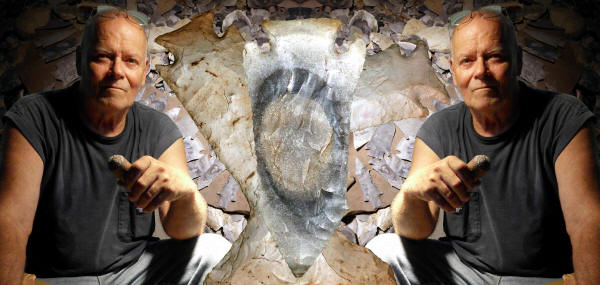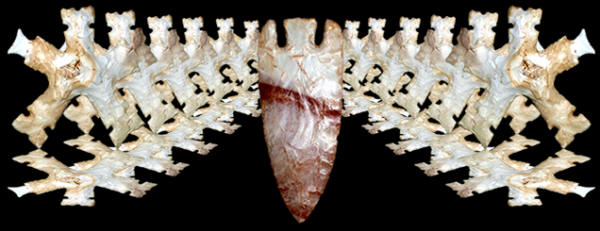|
"He (George
Eklund) is credited by many with
introducing copper billets (type of
flintknapping tool), or at least
being one of those who invented them."--------2004,
John C. Whittaker, "American Flintknappers, Stone Age Art In The
Age Of Computers" p. 76.
"For
a while he (George Eklund)
made points only partly knapped from a large flake, still attached as if
growing out of the stone."----2004,
John C. Whittaker, "American Flintknappers, Stone Age Art In The
Age Of Computers" p. 76.
"George may have
been the first modern flintknapper to use copper tools. His work shows a
wide range of talent and creativity."----2005,
Tom Onken, "Modern Lithic Artists Journal" p. 29.
"The article about you (George
Eklund) in the Community Observer was
most impressive and to sum up my feelings, I too, "dig you" as being one
of the most outstanding youngsters in your field (of
flintknapping) who can really devote
his timeless efforts in such a stimulating venture."---------1974,
Joe Bolger, Legislator - 11th District, Jackson County, Missouri, "Personal
letter to George Eklund.
"I (George Eklund)
use deer antlers, a leather pad, and sandstone. I can make about six
arrowheads an hour."------1974,
"Relics From Past, His Life's Work," The Examiner, Eastern
Jackson County's Daily Newspaper, April 23, 1974 (front page).
"Eklund says finding relics is not as important to him
as determining how they were made. He has spent seven years just
learning to chip arrowheads like the Indians did"----1974,
"Relics From Past, His Life's Work," The Examiner, Eastern
Jackson County's Daily Newspaper, April 23, 1974 (front page).
"In
1968 Eklund nearly severed a thumb while chipping and spent two months
in the hospital (printer's mistake, was not
that long). The keys to proper chipping are wrist pressure, angle,
and beveling, he said."----1974,
"Relics From Past, His Life's Work," The Examiner, Eastern
Jackson County's Daily Newspaper, April 23, 1974 (front page).
"George Eklund, a
flint knapper who operates out of Independence, Mo., was brought to the
Wichita State University campus this week by the archaeology department
for a demonstration and question-answering session."----1978,
James Michener, "Looking Sharp," The Sunflower (newspaper)
p. 5.
"The Grove (Oklahoma)
Public Library's February display features the artistry of "Flint
Knapper" George Eklund, whose wizardry in reproducing ancient artifacts
has been widely publicized and products of his talent may be found in
collections across the United States, as well as abroad."----1996,
Bob West, "Steppin Out," news paper clipping.

GEORGE EKLUND
FLINTKNAPPER
George Eklund is a well-known and respected
longtime member of the flintknapping community. He began making points
in 1963,
at the age of 13, long before there were knap-ins or anyone
teaching the public how it was done. Don Crabtree (1912-1980) didn't start
his summer field school in flintknapping until 1968. There were very few
knappers at that time. At least, no where near the numbers of people
flintknapping today. George began making "arrowheads" by experimentation
and learning on his own. He says both his parents encouraged his
interest in flintknapping, especially his mom.
If you're interested in some of
George's lithic art, you can call him at 405 473 6459 or e-mail him at
eklundgeorgesr@gmail.com |
|
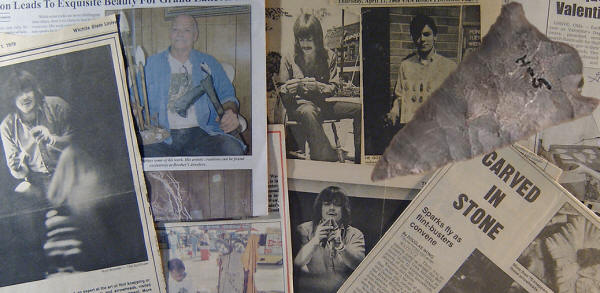
ARTICLES ABOUT GEORGE
EKLUND
Quite a lot has been written about
George Eklund over-the-years. He's appeared in many many newspaper
articles, newsletters, and books. They all seem to agree that his
flintknapping art has been a worthy endeavor. One Oklahoma newspaper
describes his ability in 1996 as "wizardry," "The Grove Public
Library's February display features the artistry of "Flint Knapper"
George Eklund, whose wizardry in reproducing ancient artifacts has
been widely publicized and products of his talent may be found in
collections across the United States, as well as abroad."
The point at upper right in this picture is the one that his
brother found and started George on his life's work of
flintknapping. This inspiration manifested in the summer of 63, when
he and his brother were crossing a field on their bikes. His brother
yelled out, "I found an arrowhead." George says, "I couldn't believe
it and something clicked in me, how did they make this?" So, as they
say, the rest is history and " the rock monster" was born. |
|
|
A person's life-path is often influenced by small events. In
George's case, his inspiration manifested in the summer of 63, when he and his
brother were crossing a field on their bikes. His brother yelled out, "I
found an arrowhead." George says, "I couldn't believe it and something
clicked in me, how did they make this?" So, as they say, the rest is
history and " the rock monster" was born. |
|

PHOTO BY DAVE DUFF & COMPUTER ALTERED BY
PETE BOSTROM
POINT-IN-STONE
ONE OF GEORGE'S SIGNATURE ART PIECES
This picture shows George Eklund
holding one of his points-in-stone lithic art pieces. The stone is a
Texas flint nodule and it measures about 14 1/2 inches (36.8 cm) from side
to side. |
|
|
George began to learn flake removal techniques by trial and
error, using everything from nails to antler. By-the-way, he says
dripping water on a hot rock doesn't work. Like Ralphie says, "you'll
shoot your eye out." He
started by using a metal hammer to remove large flakes and he removed
pressure flakes by pressing up instead of down. His path to learning
flintknapping was interrupted though. In 1968, one of these upward,
"Obsidian," flake removals almost severed his thumb and he spent several days in
the hospital. Charley Shewey is the "old time" flintknapper who later
taught George how to do proper technical percussion flaking. George said
he told him "you can't do percussion flaking by pressure," which is what
George was trying to do in the beginning. But George Eklund
did learn how to do pressure flaking on his own. |
|
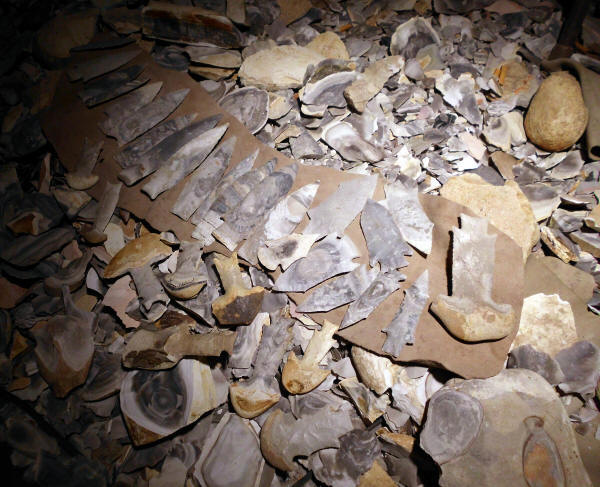
CLICK ON PICTURE FOR LARGER IMAGE
"DEBRIS FIELD" IN KNAPPING
WORKSHOP
This picture shows an area inside
George Eklund's workshop. A lot of the stone appears to be Missouri
Mozarkite. Several finished Archaic type points can be seen and a
few points-in-stone pieces. |
|
|
George is known for his ability to finish
points quickly. In fact, Some flintknappers call him "the rock monster"
because he "devours rock" so quickly. A newspaper article in 1974 quotes
him as saying, "I can make about six arrowheads in an hour." Now, in
2014, George says he can make twelve in an hour. Whittaker (2004)
writes that George is "one of the most exciting knappers to watch." He
describes him as working so fast that it's hard to follow. "He often
handles large pieces and works very fast, flipping his bifaces up in the
air as he turns them over to work on the other face and striking them
almost before they are at rest again." (Whittaker, 2004) |
|
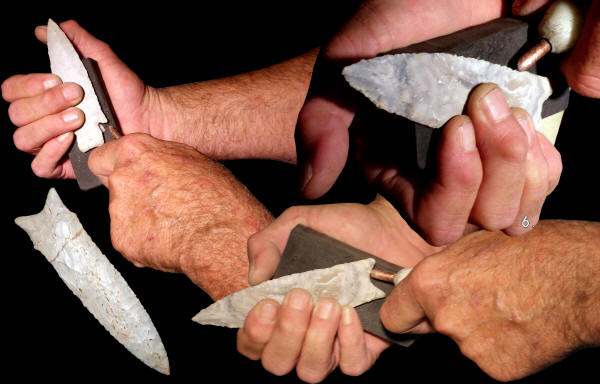
CLICK ON PICTURE FOR LARGER IMAGE
GEORGE EKLUND'S HANDS
IN VARIOUS PRESSURE FLAKING POSITIONS
This picture shows George's hands in various positions of pressure
flaking. The tool he is using is a copper pressure flaker. It's
being used to trim and thin the edge of one point and the base of a
Dalton point. The other point is a Hardin which he is shown
finishing one of the notches. |
|
|
George is credited, by some, as the inventor of
copper billets. In the very least, he is one of the inventors. He
definitely launched the idea, early on and influenced many other
flintknappers with the use of copper tools. George has been saying for a
long time, "let the tool do the work." A billet percussion flaking tool
made of copper can remove flakes much easier and faster than one made of
antler. He began using antler but switched to copper for
most of the years he has been flintknapping. Copper knapping tools are
also more durable and cost effective, compared to antler tools. He says
you have to find a piece of copper that has the right hardness for the
type of work you want to do. |
|
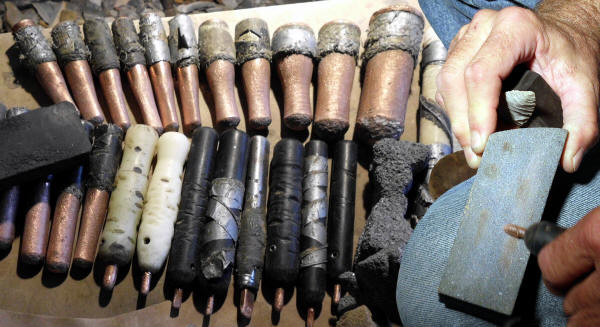
CLICK ON PICTURE FOR LARGER IMAGE
GEORGE EKLUND'S
FLINTKNAPPING TOOLS
This picture brings to mind a surgeon's
operating room where all the tools are neatly laid out. These are
the tools George Eklund uses to make his lithic art. The tools in
the top row are copper billets. The eight tools to the right in the
bottom row are copper pressure flakers. The right side of the
picture shows George resharpening one of his pressure flakers on a
small grinding stone.
George is credited, by some, as the inventor of
copper billets. In the very least, he is one of the inventors. He
definitely launched the idea, early on and influenced many other
flintknappers with the use of copper tools. A billet percussion
flaking tool made of copper can remove flakes much easier and faster
than one made of antler. George began using antler but switched to
copper for most of the years he has been flintknapping. Copper
knapping tools are also more durable and cost effective, compared to
antler tools. He says you have to find a piece of copper that has
the right hardness for the type of work you want to do. |
|
|
George Eklund is a prolific flintknapper. In other
words, he is productive, creative, and inventive. These descriptive
words reflects his ability to make unique forms of art. He may be the
first person to have made the points-in-stone art he's famous for. These
are partly finished points that are still attached to either nodules or
flakes. They appear as if they are growing or emerging from the stone.
He's also made frames of points that are mounted in soil with sticks,
stones, and other debris, as they might look when first discovered in a
field. Other forms of art include points attached onto driftwood, as if
they settled that way in a streambed. He's also hafted broken segments
of wooden shafts onto some of the points-in-stone sculptures. George is
also known for different types of eccentrics, such as Valentines Day
hearts and, believe-it-or-not, guitars. Waldorf wrote that, "He has
come up with something new that I got a kick out of. He chips a guitar
out of stone and they sell like hotcakes (Waldorf, 2006)." |
|
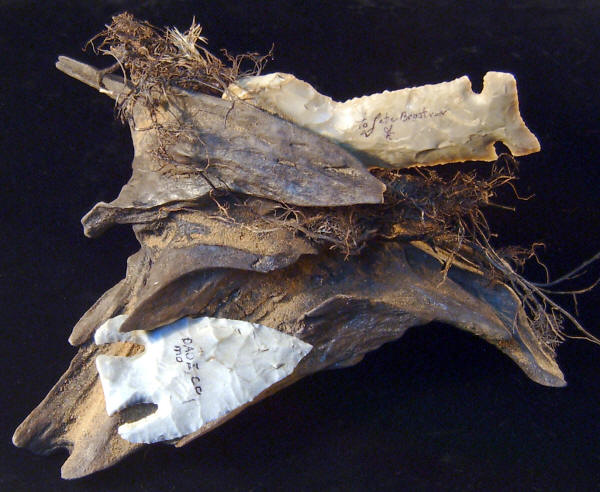
WONDERFUL EXAMPLE OF "FLINT ART"
BY GEORGE EKLUND
This is one of George's great pieces
of lithic art. The old weathered piece of wood combines very well
with the points. The points look as if they settled that way in a
streambed. The point at top is one of his point-in-stone pieces. The
bottom point is a Snyders point. This piece measures 10 inches (25,4
cm) across and 7 inches (17.7 cm) high. |
|
|
George Eklund has made all types of points. His
favorites seem to be Archaic types, like Afton, Etley, Dalton, Hardin,
corner notched, and Sedalia. But he can make any type of point,
including, very good looking fluted points and fine art points. His
flaking style is not to make them appear as perfect and uniform fine art
points. But to make them appear as "normal" and natural looking. This is
one of his unique flintknapping abilities. He can make them look old, which is
difficult to do. |
|
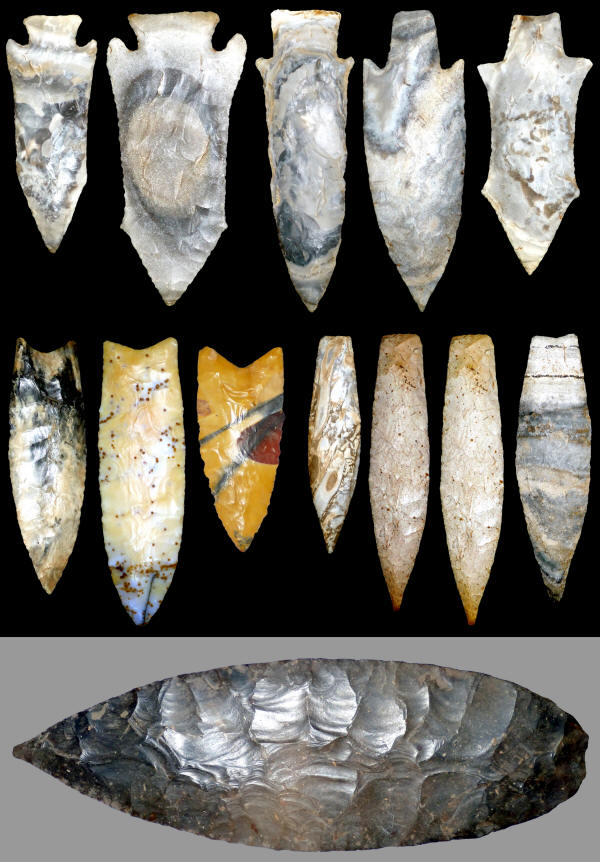
PHOTOS BY K KELLY & COMPUTER ALTERED BY PETE BOSTROM
CLICK ON PICTURE FOR LARGER IMAGE
POINTS MADE BY GEORGE EKLUND
This picture shows a few of George Eklund's
points, mostly out of Missouri chert. All the top row points appear
to all be made from Mozarkite. The biface blade at the bottom is
made from Texas Georgetown flint.
George Eklund has made all types of points. His
favorites seem to be Archaic types, like Afton, Etley, Dalton,
Hardin, corner notched, and Sedalia. But he can make any type of
point, including, very good looking fluted points and fine art
points. His flaking style is not to make them appear as perfect and
uniform fine art points. But to make them appear as "normal" and
natural looking. This is one of his unique flintknapping abilities.
He can make them look old, which can be
difficult to do. |
|
|
George Eklund has appeared in many many newspaper articles,
newsletters, and books over the years. They all seem to agree that his
flintknapping art has been a worthy endeavor. One Oklahoma newspaper
describes his ability as "wizardry," "The Grove
Public Library's February display features the artistry of "Flint
Knapper" George Eklund, whose wizardry in reproducing ancient artifacts
has been widely publicized and products of his talent may be found in
collections across the United States, as well as abroad." In 1974
he received a letter from a Jackson County Courthouse County Legislator
saying that, "The article about you in the "Community Observer" was
most impressive and to sum up my feelings, I too, "dig you" as being one
of the most outstanding youngsters in your field who can really devote
his timeless efforts in such a stimulating venture." |
|
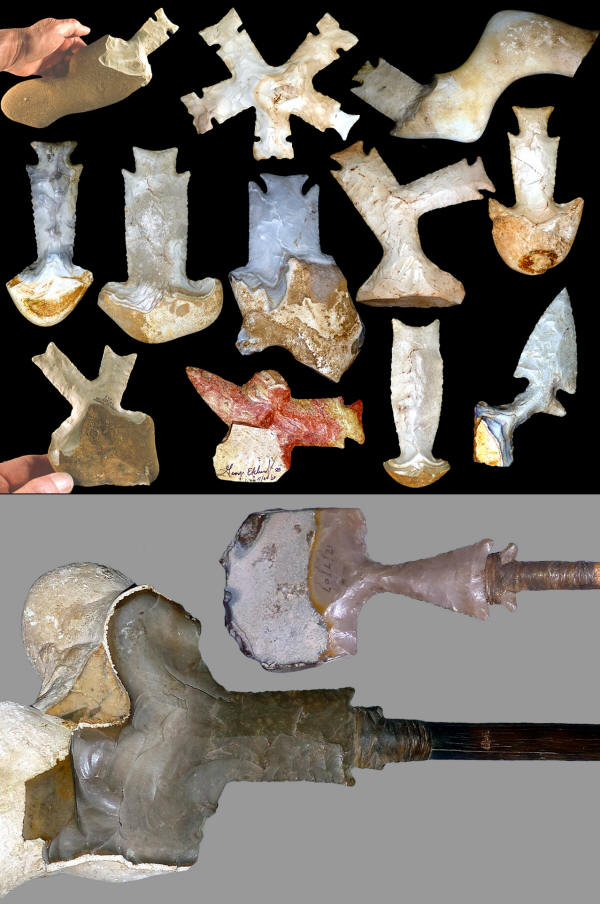
PHOTOS BY K KELLEY & COMPUTER ALTERED BY PETE BOSTROM
CLICK ON PICTURE FOR LARGER IMAGE
GEORGE EKLUND POINT-IN-STONE ART
George Eklund
may be the first person to have made the points-in-stone art he's
famous for. These are partly finished points that are still attached
to either nodules or flakes. They appear as if they are growing or
emerging from the stone. The upper portion of this picture shows
eleven of his points-in-stone art pieces. At top center, there is
another unique piece, which is five points attached together in a
circular design. The two pieces at the bottom are two examples of
his points-in-stone sculptures that are hafted with broken segments
of wooden shafts. |
|
|
Over the years, George has demonstrated flintknapping to the
general public and university students. One story involves the
anthropology department at Wichita State University. They invited him to
demonstrate the art of flintknapping to archaeology students and asked him to copy a Dalton point they
had in their collection. When he finished, they said he didn't copy it perfectly, even
though he thought he had done a pretty good job. Everything on the point
was a perfect match, except for one thing, his bevel was backwards. He
is left handed and produced a left handed bevel. The point they handed
him was made, typically, by a right handed knapper and, of course, it a
right handed bevel. |
|
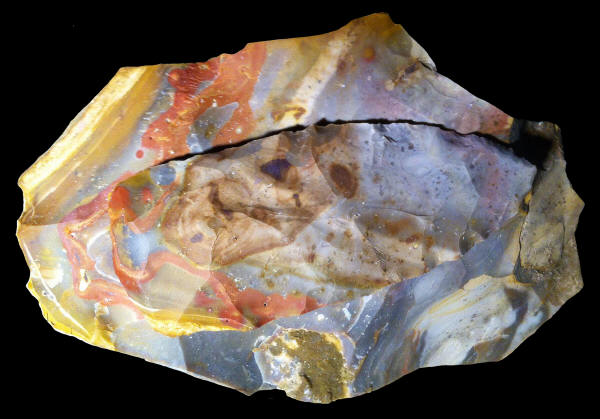
CLICK ON PICTURE FOR LARGER IMAGE
COLORFUL LAMINE RIVER CHERT
WITH GEORGE EKLUND BLANK ON TOP
This picture shows an example of a very colorful un-heat treated
chert called Lamine River chert from Saline County, Missouri. The blank setting on top of the
large flake was made by George. |
|
|
It would be safe to say that George has
produced a great many tons of points and "blanks." The blanks
are simple percussion shaped preforms that he has sold to other flintknappers.
No one will ever know how much stone George has gone through by now but
it surly must fill up one boxcar by now. |
|
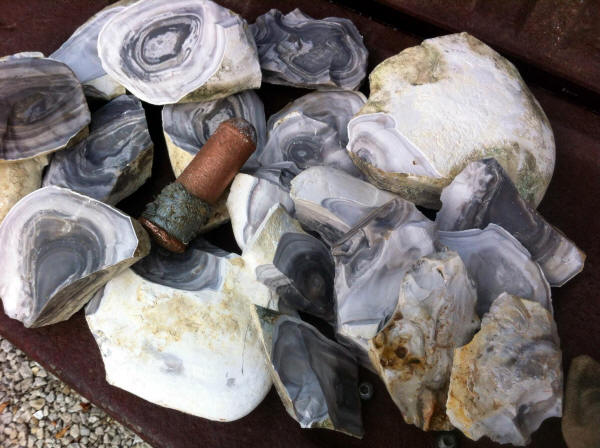
MISSOURI CHERT NODULES
This picture shows one of the types
of Missouri chert that George has used over the years. Some people
call it Jefferson City chert and others refer to it as Mozarkite. These nodules were collected in the Jefferson
City, Missouri area. |
|
|
George has used more Burlington formation chert than
anything else. Other types of rock he's used are Mozarkite and Jefferson
City chert from Missouri, Georgetown flint from Texas and Spanish
Diggings quartzite from Wyoming. Most everything he's made is raw
un-heat treated stone. He hasn't heat treated any rocks himself for
twenty years or more. What little heat treated stone he might use now, he
buys. |
|
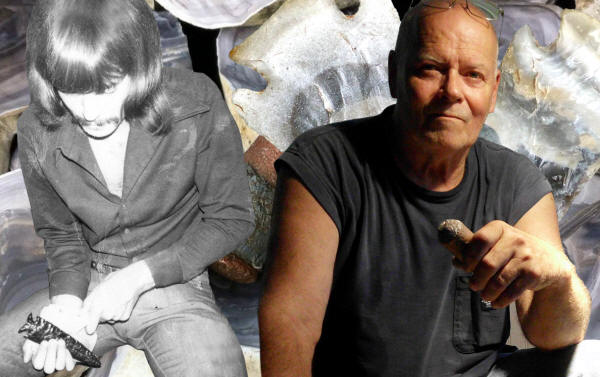
GEORGE "THE YOUNGER" &
GEORGE THE "ELDER"
This picture shows that George Eklund
has been making points for a very long time. These pictures were
taken about forty five years apart. On the left, he appears to be
pressure edge trimming a large Obsidian corner notched point with an
antler pressure flaker. On the right he's holding one of his copper
billets. |
|
|
George Eklund is a serious knapper. He's made a living
chipping rocks which is impressive on its own. His many different unique
forms of art is a pleasure look at. If there is one thing for certain,
where ever George Eklund goes, a trail of flakes aren't far behind. |
|
"REFERENCES"
1974, "Relics From Past, His Life's
Work," The Examiner, Eastern
Jackson County's Daily Newspaper, April 23, 1974 (front page).
1974, Bolger, Joe, Legislator - 11th District, Jackson County,
Missouri, "Personal letter to George Eklund.
1978, Michener, James, "Looking Sharp," The Sunflower (newspaper)
1996, West, Bob, "Steppin Out," news paper clipping.
2004, Whittaker, John C., "American Flintknappers, Stone Age Art In
The Age Of Computers."
2005, Onken, Tom, "Modern Lithic Artists Journal."
2006, Waldorf, "Chips," Vol. 18 #4.
1990 Personal Communication with George Eklund.
|
|
RECENT
LISTINGS HOME
ORDERING |
